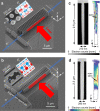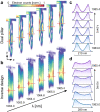Imaging the field inside nanophotonic accelerators
- PMID: 37344473
- PMCID: PMC10284904
- DOI: 10.1038/s41467-023-38857-z
Imaging the field inside nanophotonic accelerators
Abstract
Controlling optical fields on the subwavelength scale is at the core of nanophotonics. Laser-driven nanophotonic particle accelerators promise a compact alternative to conventional radiofrequency-based accelerators. Efficient electron acceleration in nanophotonic devices critically depends on achieving nanometer control of the internal optical nearfield. However, these nearfields have so far been inaccessible due to the complexity of the devices and their geometrical constraints, hampering the design of future nanophotonic accelerators. Here we image the field distribution inside a nanophotonic accelerator, for which we developed a technique for frequency-tunable deep-subwavelength resolution of nearfields based on photon-induced nearfield electron-microscopy. Our experiments, complemented by 3D simulations, unveil surprising deviations in two leading nanophotonic accelerator designs, showing complex field distributions related to intricate 3D features in the device and its fabrication tolerances. We envision an extension of our method for full 3D field tomography, which is key for the future design of highly efficient nanophotonic devices.
© 2023. The Author(s).
Conflict of interest statement
The authors declare no competing interests.
Figures





References
-
- Hamm, R. W. & Hamm, M. E. Industrial accelerators and their applications (World Scientific, 2012).
-
- Samy, H. RF linear accelerators for medical and industrial applications, 1st edn (Artech House, 2012).
-
- Apollinari, G. et al. High-Luminosity Large Hadron Collider (HL-LHC) (CERN, 2017).
-
- England RJ, et al. Dielectric laser accelerators. Rev. Mod. Phys. 2014;86:1337–1389. doi: 10.1103/RevModPhys.86.1337. - DOI
Grants and funding
LinkOut - more resources
Full Text Sources

